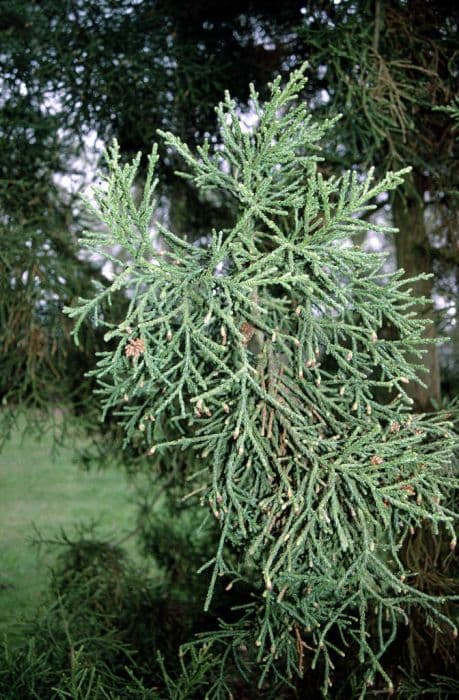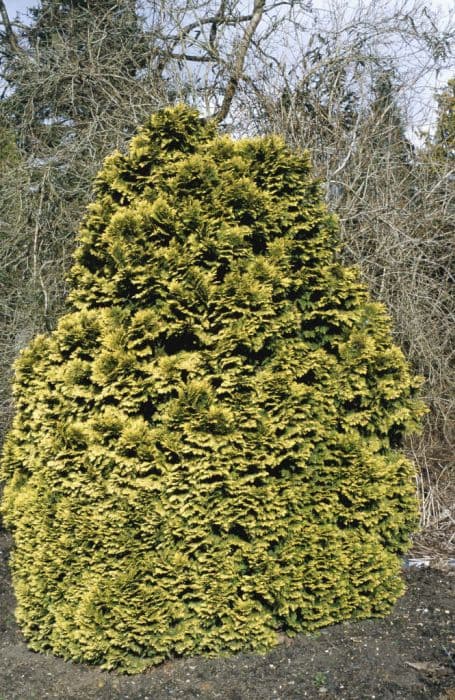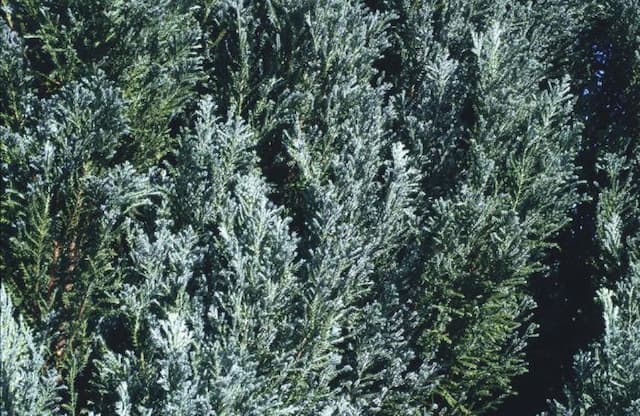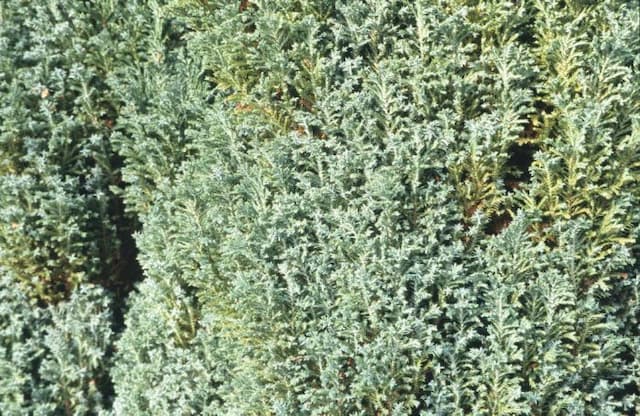Lemon Cypress Cupressus macrocarpa 'Golden Cone'

ABOUT
The 'Golden Cone' Monterey Cypress is a visually appealing plant that stands out due to its distinctive foliage, which displays a vibrant golden-yellow color particularly on the tips. This evergreen conifer has a pyramidal shape with dense, scale-like leaves that hug closely to the branches, creating a compact and neat appearance. The foliage tends to be more intensely colored in full sun, slowly transitioning to a more greenish-gold hue in the shaded parts or during the less intense winter light. As with other Monterey Cypress varieties, the 'Golden Cone' develops small, round cones that add an additional textural element to its appearance. The combination of its conical form, striking color, and lush foliage makes it an excellent choice as a specimen plant in a garden design or as part of a border or screen for year-round interest.
About this plant
 Names
NamesFamily
Cupressaceae
Synonyms
Monterey Cypress 'Golden Cone', Lemon Cypress, Golden Monterey Cypress
Common names
Cupressus macrocarpa 'Golden Cone'.
 Toxicity
ToxicityTo humans
Monterey Cypress 'Golden Cone' is not commonly associated with toxicity to humans. Generally, ingesting parts of the plant is unlikely to cause poisoning. Nonetheless, it is always advisable for individuals, especially children, to avoid consuming plant material that is not known to be edible, as it can pose a risk of choking or cause gastrointestinal discomfort or an allergic reaction in sensitive individuals.
To pets
Monterey Cypress 'Golden Cone' is also not commonly known to be toxic to pets. However, similarly to humans, ingestion of plant parts by pets should be discouraged. While no specific toxic effect is usually reported, consuming non-edible plant material can lead to gastrointestinal upset in animals, including vomiting and diarrhea. It is always best to keep an eye on pets and prevent them from eating ornamental plants.
 Characteristics
CharacteristicsLife cycle
Perennials
Foliage type
Evergreen
Color of leaves
Golden
Height
10 feet [3 meters]
Spread
8 feet [2.4 meters]
Plant type
Tree
Hardiness zones
7
Native area
California
Benefits
 General Benefits
General Benefits- Aesthetic Appeal: Monterey Cypress 'Golden Cone' offers striking year-round golden-yellow foliage that enhances garden color schemes.
- Privacy Screen: It can be used to create a privacy screen or hedge due to its dense growth habit.
- Windbreak: The thick foliage and sturdy growth make it an excellent windbreak in coastal and windy areas.
- Low Maintenance: Once established, it requires minimal care, making it a suitable choice for those seeking a low-maintenance plant.
- Drought Resistance: It has good drought tolerance once established, reducing the need for frequent watering.
- Erosion Control: Its root system helps stabilize slopes and prevent erosion.
- Habitat Support: Provides shelter and nesting sites for birds and other wildlife.
- Versatility: Suitable for a variety of landscape uses, including as a specimen plant, in borders, or for topiary.
 Medical Properties
Medical PropertiesThis plant is not used for medical purposes.
 Air-purifying Qualities
Air-purifying QualitiesThis plant is not specifically known for air purifying qualities.
 Other Uses
Other Uses- The wood of the Monterey cypress can be used in woodworking projects, like crafting small pieces of furniture or decorative items, due to its fine grain and workability.
- Monterey cypress can be cultivated as a bonsai tree, offering a creative and meditative hobby for enthusiasts who appreciate shaping and caring for miniature trees.
- The tree's dense foliage makes it suitable for creating privacy screens or hedges in landscaping, providing both a sound barrier and windbreak for residential areas.
- Due to its sturdy nature, the wood from the Monterey cypress is sometimes used in outdoor construction for things like fences, decks, and garden structures.
- The trees can be planted along coastlines to help reduce erosion, as their root systems bind the soil effectively.
- Artists can use the cones and foliage of the Monterey cypress in floral arrangements or as components in natural art installations.
- The large size and dramatic form of the Monterey cypress make it a striking photographic subject for nature photographers.
- Its aromatic wood can be used to produce scented items like essential oils or potpourri, bringing a forest-like fragrance into homes.
- The tree's flammable wood and rich resin content can be utilized in making kindling or fire starters for campfires and wood stoves.
- In some specialized markets, the wood from the Monterey cypress is sought after for creating veneers due to its attractive appearance.
Interesting Facts
 Feng Shui
Feng ShuiThe Monterey Cypress is not used in Feng Shui practice.
 Zodiac Sign Compitability
Zodiac Sign CompitabilityThe Monterey Cypress is not used in astrology practice.
 Plant Symbolism
Plant Symbolism- Immortality: The Cupressus macrocarpa, commonly known as the Monterey Cypress, is an evergreen conifer, which often symbolizes immortality and eternal life due to its long lifespan and green foliage throughout the year.
- Strength: The wood of the Monterey Cypress is known for its durability and resistance to the elements, which lends the symbolic meaning of strength and resilience to this plant.
- Protection: Since ancient times, cypress trees have been planted in sacred spaces and cemeteries to ward off evil spirits, representing protection and guardianship.
- Longevity: Owing to the longevity of these trees, which can live for hundreds of years, the Monterey Cypress is often associated with long life and endurance.
- Peace and Tranquility: The presence of the Monterey Cypress in gardens and landscapes is believed to bring about a sense of peace and tranquility, reflecting its calm and serene appearance.
 Water
WaterMonterey Cypress 'Golden Cone' should be watered thoroughly, allowing the soil to dry slightly between waterings. During the growing season, water the plant about once a week with approximately one to two gallons, depending on the size of the plant and the weather conditions. During winter months, reduce the frequency to every two to three weeks, providing less water as the plant's growth slows. Ensure that the soil drains well to avoid waterlogging which can lead to root rot. Adjust watering based on rainfall, lessening the amount if precipitation is sufficient.
 Light
LightMonterey Cypress 'Golden Cone' thrives in a location that receives full sunlight for at least six to eight hours a day. The best spot for this plant is an open area where it's exposed to unfiltered, direct sun, as this will promote the healthiest growth and the best golden-hued foliage. Avoid deeply shaded areas as this will not provide the light conditions that the 'Golden Cone' requires for optimal health.
 Temperature
TemperatureMonterey Cypress 'Golden Cone' is well-suited to a temperate climate and can handle a temperature range from about 20°F to 100°F. The ideal temperature for this plant to thrive is between 60°F and 80°F. While the plant is frost tolerant, prolonged exposure to temperatures below 20°F can be detrimental.
 Pruning
PruningPrune the Monterey Cypress 'Golden Cone' to maintain its conical shape and to remove any dead or damaged branches. Pruning is best done in late winter or early spring before new growth begins. This plant does not require extensive pruning, so limit cuts to shaping and health maintenance. Prune sparingly, as the tree can react poorly to heavy cutting back.
 Cleaning
CleaningNot needed
 Soil
SoilMonterey Cypress 'Golden Cone' prefers well-draining soil with a slightly acidic to neutral pH of 6.0 to 7.5. A good soil mix can consist of two parts loam, one part peat moss, and one part sand or perlite to improve drainage. Ensuring proper drainage will prevent root rot and provide the tree with the ideal growing conditions.
 Repotting
RepottingThe Monterey Cypress 'Golden Cone' does not have to be repotted often; young plants may be repotted every 2-3 years. Once established and mature, repotting is done infrequently and only if the plant becomes root-bound or the soil becomes depleted, generally every 4-5 years or as needed.
 Humidity & Misting
Humidity & MistingMonterey Cypress 'Golden Cone' is adaptable to a wide range of humidity levels but grows best in moderate to high humidity. This plant does not have specific humidity requirements, making it versatile and capable of thriving in average outdoor conditions.
 Suitable locations
Suitable locationsIndoor
Place in bright, indirect light; avoid dry air and drafts.
Outdoor
Full sun, shelter from winds, mulch roots, and water deeply.
Hardiness zone
7-10 USDA
 Life cycle
Life cycleThe Monterey Cypress 'Golden Cone' begins its life cycle as a seed, which will germinate given the right conditions of soil moisture and temperature. Upon germination, the seedling emerges, developing roots and a primary shoot that allows the plant to start photosynthesis. As the plant grows, it enters the vegetative stage, characterized by the development of a conical shape and foliage that changes from juvenile to adult form, with the adult leaves being scale-like and arranged in opposite decussate pairs. The 'Golden Cone' variety is distinguished by its bright yellow-green foliage during this stage. After several years, the tree reaches maturity and begins its reproductive phase, producing small male and female cones on the same plant. Once the female cones are pollinated, they develop seeds that eventually mature, drop to the ground, and have the potential to grow into new trees, completing the cycle.
 Propogation
PropogationPropogation time
Early Spring
The Monterey Cypress 'Golden Cone' is typically propagated by semi-hardwood cuttings. This method involves taking cuttings from the current year's growth in late summer to fall, ensuring that each cutting has several nodes. The process starts by selecting healthy, disease-free material, cutting pieces about 6 to 8 inches long. The lower leaves are removed, and the cut end is treated with a rooting hormone to encourage root development. The cuttings are then inserted into a well-draining potting mix, with the bottom half of the cutting buried in the soil. It is crucial to maintain a humid environment around the cuttings, often achieved by using a plastic cover or placing them in a misting chamber until roots have developed, which can take several weeks to a few months. During this time, the cuttings should be kept out of direct sunlight and watered regularly to keep the soil moist but not waterlogged.









